Table of Contents
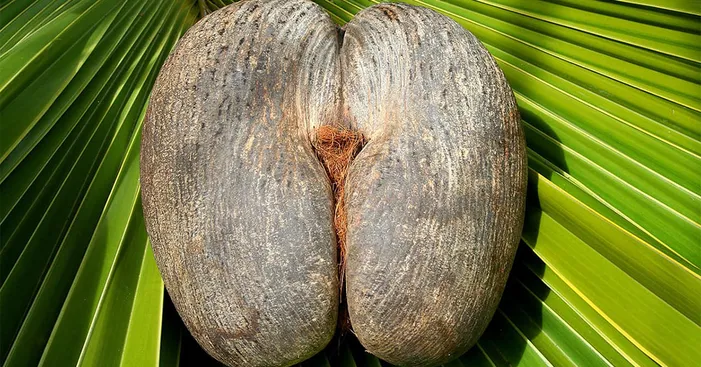
The coco de mer, a unique palm tree native to the Seychelles islands of Praslin and Curieuse, holds the distinction of producing the largest seed in the plant kingdom.
Once also found on Île Saint-Pierre, Île Chauve-Souris, and Île Ronde, this critically endangered species is now protected by law.
Despite its rarity, the coco de mer continues to be cultivated in the Seychelles for genetic preservation and as an ornamental tree in many tropical regions.
This majestic palm can reach heights of 25 to 34 meters, adorned with impressive fan-shaped leaves that span 7 to 10 meters in length and 4.5 meters in width.
Unlike the Tal tree, known locally as Lodoicea maldivica, the coco de mer exhibits dioecious characteristics, with male and female trees being distinct entities.
The towering male flowers of the sea coconut palm resemble catkins and can reach an impressive length of up to a meter.
Encased within the massive coconut fruit lies the largest seed in the plant kingdom.
Measuring 40 to 50 centimeters in diameter and weighing a hefty 15 to 30 kilograms, the mature fruit takes a remarkable 6 to 7 years to develop and a further two years to germinate.
These colossal fruits are sometimes referred to as double coconuts, coco fesse, or Seychelles nuts in other parts of the world.
General facts about coco de mer:
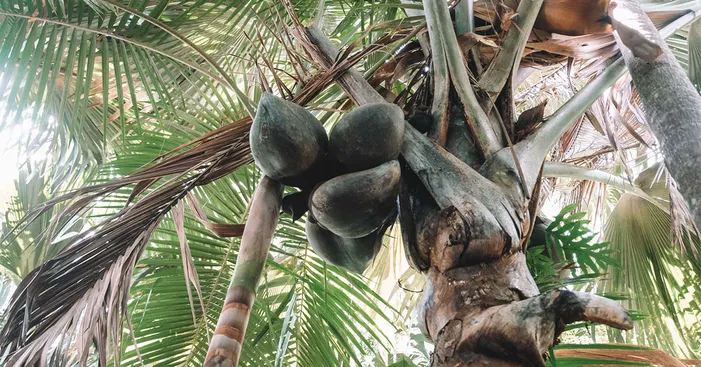
Overview:
The dioecious coco de mer palm, with its separate male and female counterparts, can reach an impressive height of 30 to 35 meters.
Its crown is adorned with long, broad, fan-shaped leaves, adding to its majestic presence.
Despite its name, the ‘coco-fesse’, meaning ‘coconut buttocks’ in French, is not the fruit of the coco de mer but rather its remarkable seed.
Each fruit can harbor one to three of these ‘coco-fesses’, each weighing up to an astonishing 15 kilograms.
The heaviest fruit ever recorded tipped the scales at a staggering 42 kilograms.
Cultivation of this botanical marvel, Lodoicea maldivica, is a rare endeavor due to its exceptionally slow germination rate and strict regulations governing seed export.
As an example of this exclusivity, Prince William and Kate Middleton received a ‘coco de mer” as a wedding gift during their honeymoon in the Seychelles, accompanied by a special export permit.
Random facts about Coco de Mer:
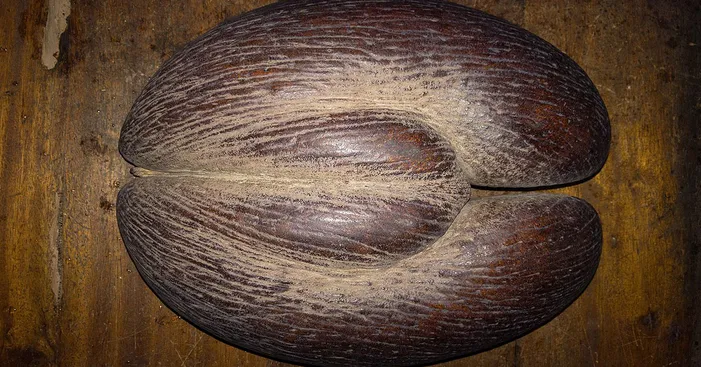
- Traditionally, the seeds were eaten, traded, or given as gifts.
- The seeds are so heavy that they sink to the bottom of the sea when they fall off the tree.
- As time passes, the insides decompose and the outer shell floats to the surface.
- Fishermen used to think that the seeds grew on the bottom of the ocean.
- An archaic botanical name for the plant was Lodoicea callipyge, which means “beautiful buttocks” in Greek.
- The canopy of the palm tree has fronds spanning almost five meters outwards.
- Additional Information
- The coco de mer is a dioecious plant, meaning that male and female flowers are produced on separate trees.
- The male flowers are long and slender, while the female flowers are large and spiky.
- The fruit of the coco de mer is a large, double-lobed nut that can weigh up to 42 kilograms.
- The nut takes up to 10 years to mature and contains a single seed.
- The seeds are edible and were once a valuable trade item.
- The coco de mer is an important symbol of the Seychelles and is featured on the country’s coat of arms.
Taste of coco de mer:

With its delicate balance of sweetness and earthiness, the coco de mer offers a unique flavor profile that has been likened to a fusion of mango, banana, and even breast milk.
When fully mature, its texture resembles a refined version of coconut flesh, while its immature form boasts a softer consistency akin to Turkish delight.
Unlike the familiar coconut, which features a single lobe encasing a hollow, milk-filled center, the coco de mer possesses two distinct lobes filled with delectable flesh.
This remarkable fruit’s development spans seven years, resulting in an exceptionally thick shell that can only be breached with a saw.
Legends about coco de mer:
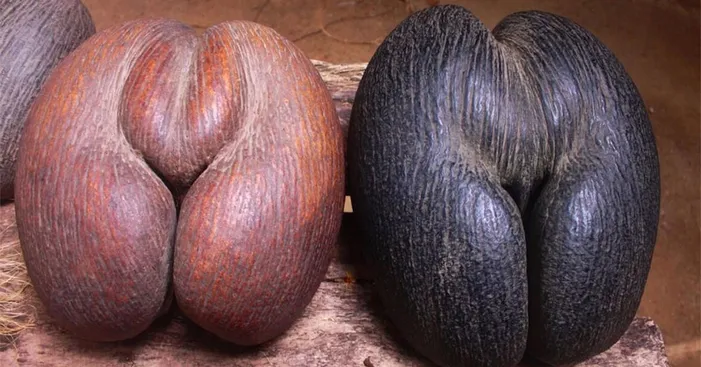
The coco de mer, a unique palm tree native to the Seychelles islands, has inspired a rich tapestry of myths and legends.
Its distinctive double fruits, remarkably resembling male and female anatomy, have given rise to tales of nocturnal trysts between the trees.
It is said that only under the cloak of darkness when the streets are deserted, do the trees come together in a passionate embrace.
Those unfortunate enough to witness this sacred union are warned of dire consequences, facing the risk of blindness or even death.
The coco de mer’s journey to the Maldives, its initial presumed homeland, is shrouded in mystery.
The fruits were once considered the exclusive property of the Maldivian king, and any attempt to conceal a discovery could result in severe punishment, including the loss of hands.
Another legend links the coco de mer to the forbidden fruit of the Garden of Eden.
British Major-General Charles George Gordon, upon encountering the coco de mer’s distinctly erotic form during his visit to the Seychelles islands in 1881, proposed the intriguing notion that it was the very fruit Eve offered to Adam.
Malayan sailors, mesmerized by the sight of coco de mer fruits seemingly floating upwards from the ocean depths, firmly believed that these enigmatic fruits originated from underwater trees.
In their imaginations, these underwater groves were home to Garuda, a sacred bird of immense size and power.
The coco de mer holds a special place in the hearts of the Seychellois people, who revere its purported medicinal and aphrodisiac properties.
They firmly believe in the fruit’s ability to heal and enhance vitality, making it a highly prized possession.
Coco de mer health benefits:
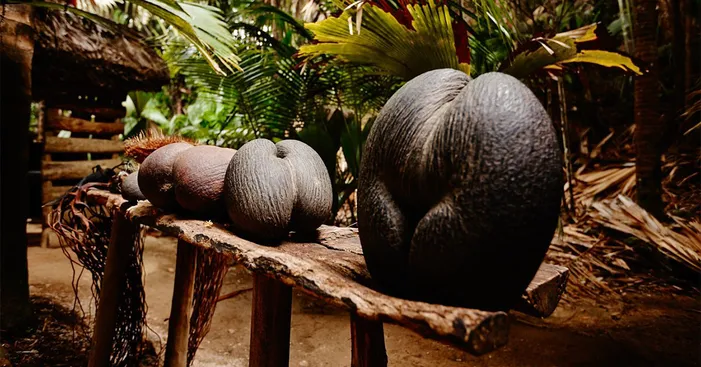
Good for the liver:
The treasure trove of nutrients in coco de mer, including vitamin E and healthy fats, may play a crucial role in supporting the liver’s detoxifying functions, helping it effectively neutralize and eliminate harmful substances from the body.
Vitamin E, a potent antioxidant, acts as a shield against oxidative stress, protecting the liver cells from damage caused by free radicals.
Healthy fats, particularly monounsaturated and polyunsaturated fats, contribute to reducing inflammation and improving insulin sensitivity, both of which are essential for maintaining liver health.
Remember, a healthy liver is essential for overall well-being.
By embracing the power of nuts and seeds, you can empower your liver to perform its vital detoxification tasks, keeping you healthy and energized.
Heart health:
There is some evidence that the Coco de Mer nut may be beneficial for heart health.
One study found that people who consumed a diet rich in nuts, including the Coco de Mer nut, had a lower risk of developing heart disease.
Another study found that the Coco de Mer nut contains compounds that can help to lower blood pressure.
Digestive benefits:
Coco de Mer nuts are a rich source of dietary fiber, a crucial component of a healthy digestive system.
Consuming adequate fiber can aid in preventing constipation and maintaining overall digestive health.
Brain health:
The Coco de Mer nut is a rich source of essential fatty acids, including omega-3 and omega-6, which are crucial for maintaining optimal brain health.
These fatty acids play a vital role in the structure and function of brain cells, and studies have shown that they may contribute to improved cognitive function and mental well-being.
Consuming adequate amounts of omega-3 and omega-6 fatty acids has been associated with a reduced risk of neurodegenerative diseases, enhanced memory and learning abilities, and improved mood regulation.
Therefore, incorporating Coco de Mer nut into one’s diet may be a beneficial step towards promoting brain health and overall well-being.
Anti-inflammatory properties:
While the anti-inflammatory properties of bioactive compounds in certain nuts and seeds have been demonstrated, the Coco de Mer nut’s potential to reduce inflammation remains unexplored.
Although research on the anti-inflammatory effects of bioactive compounds in nuts and seeds is extensive, the potential of Coco de Mer nut in this regard remains unknown.
Though some nuts and seeds have shown anti-inflammatory properties, the Coco de Mer nut’s potential in this area requires further investigation.
Despite the evidence supporting the anti-inflammatory properties of certain nuts and seeds, the Coco de Mer nut’s potential in this domain needs further exploration.
Precautions before you consume coco de mer:

Coco de mer is very healthy but like any other type of food, it can cause some side effects including:
Digestive sensitivity
Coco de Mer nuts are high in fiber, which can cause digestive problems in some people.
If you have a sensitive stomach, it is best to avoid Coco de Mer nuts or to eat them in moderation.
Unfamiliar allergens
Even though there is not much known about Coco de Mer nut allergens, it is possible that some people could be allergic to certain compounds in the nut.
If you have allergies to other nuts or seeds, it is best to talk to your doctor before trying Coco de Mer nuts.
Contamination
Like any other food, Coco de Mer nuts could be contaminated with microbes or other harmful substances if they are not handled properly.
It is important to purchase Coco de Mer nuts from a reputable source and to store them properly to prevent contamination.
Unfamiliarity
Coco de Mer nuts are not a common food, so it is possible that eating a lot of them or eating them in a way that you are not used to could cause stomach upset.
If you are new to Coco de Mer nuts, it is best to start with a small amount and see how you tolerate them.
Allergies
There is not much known about Coco de Mer nut allergies, but people with nut allergies could be sensitive to the proteins in the nut.
If you are allergic to nuts, it is best to avoid Coco de Mer nuts altogether.
Using coco de mer:
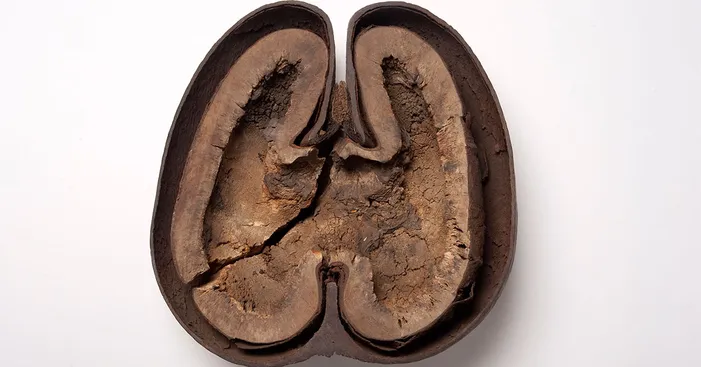
One of the uses of the coco de mer is the production of nira, which can be processed into sugar, similar to the sap obtained from regular coconut palms.
Historically, the tal leaf portion of the tree was widely used as a writing surface before the invention of paper.
Coconut palm leaves can also be utilized in various ways, including making fans, roofing materials, mats, hats, bags, and baskets, especially in rural areas.
A Culinary Treat for the Taste Buds
The true essence of the Coco de mer lies within its edible endosperm, a succulent delight that tantalizes the taste buds.
Immature seeds offer a jelly-like substance that melts in the mouth, leaving behind a sweet and delectable flavor.
Locals savor this delicacy, considering it a culinary gem.
In southern Chinese cuisine, particularly around the Canton region, the Coco de Mer finds its place as a flavor enhancer, adding an extra layer of depth to soups and other dishes.
Medicinal Properties: A Legacy of Healing
Throughout history, the Coco de mer has been revered for its medicinal properties, believed to possess the power to ward off life-threatening ailments.
Ayurvedic medicine incorporates fruit into preparations like kashaya mridha sanjivini gulika, while Siddha medicine employs it to treat diabetes, vomiting, and libido issues.
Traditional Chinese medicine also recognizes the Coco de Mer’s value, utilizing its jelly-like flesh for its purported medicinal benefits.
A Treasure from Nature’s Pharmacy
The Coco de Mer stands as a testament to nature’s remarkable ability to provide both culinary and medicinal wonders.
Its restricted availability and the challenges of cultivation only add to its mystique and allure.
As we continue to explore the vast potential of natural remedies, the Coco de Mer remains a captivating symbol of hope and healing.
Buying coco de mer:
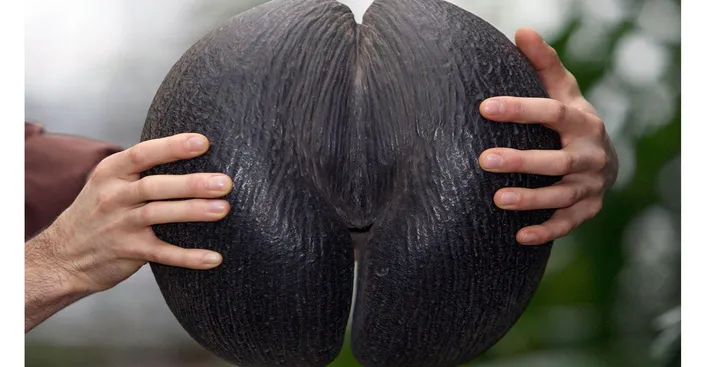
On the idyllic islands of Seychelles, a peculiar fruit reigns supreme – the Coco de Mer.
Renowned for its captivating shape and symbolic significance, this unique plant has captivated the world’s imagination for centuries.
The exclusivity of Coco de Mer is evident in its meticulously controlled collection.
Each fruit is carefully numbered, ensuring its traceability and protecting this precious resource.
Official records indicate an annual sale of approximately a thousand fruits, but the true number may be lower due to illegal harvesting.
To acquire an authentic Coco de Mer souvenir, prospective buyers can visit the renowned Valle-de-Mai Nature Reserve, where every coconut bears an official certificate of authenticity.
Alternatively, the bustling capital of Seychelles, Victoria, offers a selection of certified souvenirs.
When purchasing a Coco de Mer, it is crucial to verify the accompanying documentation to confirm its legitimacy and sustainable collection practices.
Prices for these remarkable fruits range from 200 to 600 dollars, reflecting their rarity and significance.
The Seychelles Ministry of Environment meticulously oversees the collection of Coco de Mer fruits.
Proceeds generated from souvenir sales are reinvested into the republic’s ecological initiatives, ensuring the preservation of this natural treasure for generations to come.
Coco de Mer stands as a testament to Seychelles’ extraordinary biodiversity and serves as a source of national pride.
If you are fortunate enough to embark on a Seychellois adventure, don’t miss the opportunity to witness this awe-inspiring plant firsthand.
